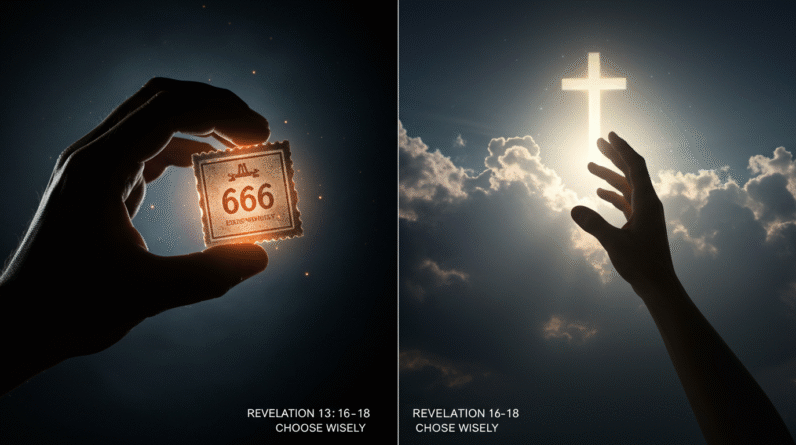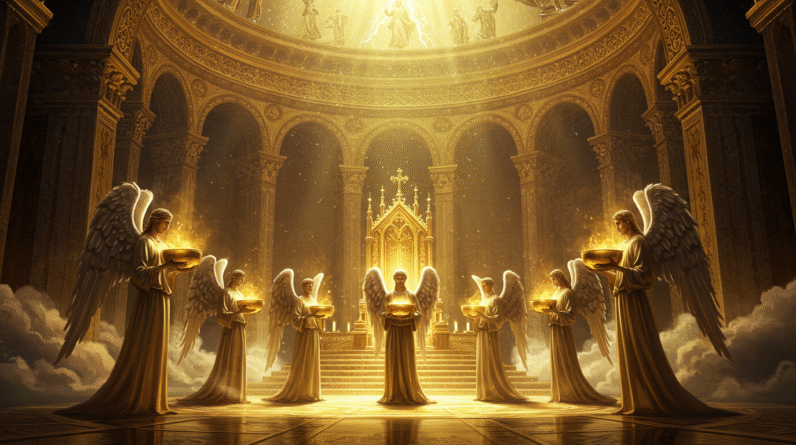Explore the celestial harmonies in Revelation 14:3, where worship and redemption unite. Discover insight and hope through this heavenly vision.
The New Song of Heaven: Worship Born of Redemption — Revelation 14:3
Introduction: Setting the Scene
Imagine a scene where the heavens burst into song, a chorus of celestial beings singing in unison. This is what we encounter in Revelation 14:3. Here, John writes about a “new song” that only the redeemed can learn and sing. The backdrop to this heavenly melody is tumultuous, with spiritual battles unfolding and the earth teetering on the edge of chaos. It offers a moment of serenity and awe, a respite for believers amid the unfolding divine drama. In this scene, Revelation gives us a glimpse into a vision that’s as vivid as it is profound, calling believers to reflect on their own understanding of redemption and worship.
Why it Matters
So, why does this vision of a new song resonate even today? Within the grander narrative of Revelation, it holds a special place as a declaration of redemption — it’s not just a song, but a testament to God’s saving grace woven into the lives of believers. As chaos stirs on earth, this song becomes a signal of hope, a promise of redemption that is both present and eternal. For modern believers, it underscores the truth that amidst life’s uncertainties, there is a divine order, a redemption that transforms and renews.
Exploring the Vision in Depth
Summary of Key Symbols
The “new song” in Revelation 14:3 is laden with symbolism. On one hand, it’s a melody that only the redeemed — those who have lived and suffered for their faith — can learn, marking them as chosen by God. This exclusivity suggests a deep, intimate knowledge bestowed by the divine. Moreover, the very act of singing signifies worship and adoration, an exercise of faith that draws from the depths of human experience with God. It’s a song of personal and collective victory, resonating with themes of triumph over adversity and the journey of faith.

Contextual Background
To fully appreciate this vision, it helps to understand its context. Revelation was penned during a time of severe persecution for early Christians. They endured hardship not only at the hands of human authorities but also against spiritual forces. This period of trial and tribulation forms the backdrop of the new song. In connecting with other passages like Revelation 5, where the Lamb is found worthy to break the seals, we see a consistent theme of redemption at play. The “new song” serves as a continuation of God’s promise to His people — one of victory over sin and evil, echoing the covenant made throughout biblical history.
Interpretation
Interpreting the “new song” involves delving into its layers of meaning. It stands as a testament to the redemptive journey — one that transforms suffering into praise and despair into worship. Each note reflects a life redeemed, signaling not just survival, but triumph. The exclusivity of the song-learning process marks it as a symbol of spiritual maturity and divine recognition. Through this, Revelation portrays a narrative that is not only historical but ongoing; one that invites every believer into the storied tapestry of God’s plan.
Relevance for Today’s Readers
Spiritual Insight
Today, believers find themselves navigating an increasingly complex and often contradictory world. In this labyrinth, the message of a “new song” offers vital spiritual insight: our lives, though fraught with challenges, are arenas for encountering God’s redemptive work. It underlines the importance of worship as an active, transformative aspect of our faith journey, calling us to engage with it deeply.
Application in Daily Life
Navigating daily life with the message of this vision can invite a shift in perspective. Every challenge and joy, when viewed through the lens of redemption, holds potential for worship. This could mean finding sanctuary in moments of quiet praise or recognizing divine grace in life’s unexpected blessings. The “new song” encourages us to live fully aware of and fully participate in God’s redeeming love.
Supporting Verses and Cross-References
To deepen our understanding, we can explore related scriptures that mirror the themes of worship and redemption. Take, for example, Psalm 40:3, where the psalmist speaks of a new song put into their mouth as a testament to God’s intervention. Similarly, Ephesians 5:19-20 encourages believers to sing and make music from the heart to the Lord. These verses root the concept of a transformative, divine song securely in biblical tradition, affirming its timeless resonance across the canon of Scripture.
Conclusion: Reflection on the Vision’s Message
Summarizing the essence of the “new song” involves acknowledging its deep-rooted call to worship that springs from redemption. It challenges believers to live in a posture of expectant praise, recognizing the divine narrative in their everyday lives. In reflecting on this vision, we are encouraged to meditate on its relevance—not just in our personal spheres, but in how we perceive spiritual and communal identity within God’s larger story.
Emphasizing this eternal message, the “new song” ultimately becomes a call to faith, inviting believers to stand firm and sing boldly of redemption in every aspect of their existence. Psalm 96:1-2 reminds us to “Sing to the Lord a new song; sing to the Lord, all the earth,” echoing the diverse, inclusive, and eternal song of the redeemed.







